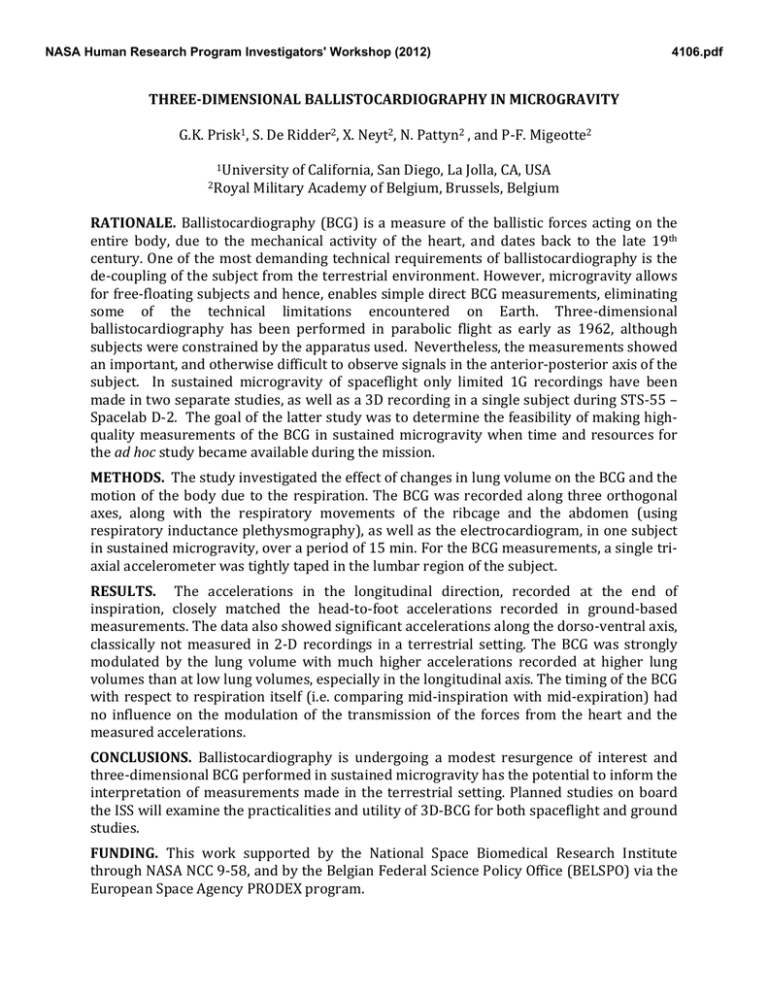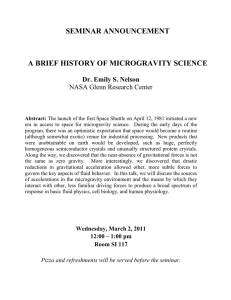Document 14552454
advertisement

NASA Human Research Program Investigators' Workshop (2012) 4106.pdf THREE-­DIMENSIONAL BALLISTOCARDIOGRAPHY IN MICROGRAVITY G.K. Prisk1, S. De Ridder2, X. Neyt2, N. Pattyn2 , and P-­‐F. Migeotte2 1University of California, San Diego, La Jolla, CA, USA 2Royal Military Academy of Belgium, Brussels, Belgium RATIONALE. Ballistocardiography (BCG) is a measure of the ballistic forces acting on the entire body, due to the mechanical activity of the heart, and dates back to the late 19th century. One of the most demanding technical requirements of ballistocardiography is the de-­‐coupling of the subject from the terrestrial environment. However, microgravity allows for free-­‐floating subjects and hence, enables simple direct BCG measurements, eliminating some of the technical limitations encountered on Earth. Three-­‐dimensional ballistocardiography has been performed in parabolic flight as early as 1962, although subjects were constrained by the apparatus used. Nevertheless, the measurements showed an important, and otherwise difficult to observe signals in the anterior-­‐posterior axis of the subject. In sustained microgravity of spaceflight only limited 1G recordings have been made in two separate studies, as well as a 3D recording in a single subject during STS-­‐55 – Spacelab D-­‐2. The goal of the latter study was to determine the feasibility of making high-­‐ quality measurements of the BCG in sustained microgravity when time and resources for the ad hoc study became available during the mission. METHODS. The study investigated the effect of changes in lung volume on the BCG and the motion of the body due to the respiration. The BCG was recorded along three orthogonal axes, along with the respiratory movements of the ribcage and the abdomen (using respiratory inductance plethysmography), as well as the electrocardiogram, in one subject in sustained microgravity, over a period of 15 min. For the BCG measurements, a single tri-­‐ axial accelerometer was tightly taped in the lumbar region of the subject. RESULTS. The accelerations in the longitudinal direction, recorded at the end of inspiration, closely matched the head-­‐to-­‐foot accelerations recorded in ground-­‐based measurements. The data also showed significant accelerations along the dorso-­‐ventral axis, classically not measured in 2-­‐D recordings in a terrestrial setting. The BCG was strongly modulated by the lung volume with much higher accelerations recorded at higher lung volumes than at low lung volumes, especially in the longitudinal axis. The timing of the BCG with respect to respiration itself (i.e. comparing mid-­‐inspiration with mid-­‐expiration) had no influence on the modulation of the transmission of the forces from the heart and the measured accelerations. CONCLUSIONS. Ballistocardiography is undergoing a modest resurgence of interest and three-­‐dimensional BCG performed in sustained microgravity has the potential to inform the interpretation of measurements made in the terrestrial setting. Planned studies on board the ISS will examine the practicalities and utility of 3D-­‐BCG for both spaceflight and ground studies. FUNDING. This work supported by the National Space Biomedical Research Institute through NASA NCC 9-­‐58, and by the Belgian Federal Science Policy Office (BELSPO) via the European Space Agency PRODEX program.





